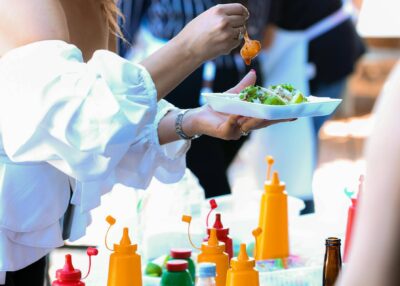The Ultimate Guide to Planning a Jazz Festival: Setting the Stage!
Organizing a jazz festival is a labor of love, a harmonious symphony of creativity and logistics. Whether you're an experienced event planner or a jazz enthusiast with a dream, this comprehensive guide will take you through the process of planning a successful jazz festival.
From highlighting the talent and creating a compelling schedule to marketing strategies and financial considerations, we've got you covered.
Setting the Stage
Define Your Vision: Before diving into the details, begin with a clear vision for your jazz festival.
What is the festival's theme or concept?
What makes it unique compared to other music events?
Think about the style, size, and atmosphere you want to create. Your vision will serve as the guiding light throughout the planning process.
Secure Talent: One of the key attractions of any music festival is the talent lineup. To make your jazz festival unforgettable, secure a main performer or headlining act that resonates with your target audience. The headliner can serve as a draw for attendees and set the tone for your festival.
Many established artists work through booking agents or managers. Contacting these professionals can be an effective way to initiate discussions with potential headliners. Booking agents are experienced in negotiating contracts, and they can help you navigate the process smoothly.
While securing a renowned headliner is essential, don't overlook the potential of local jazz talent. Including local musicians or bands in your lineup can provide a unique flavor to your festival and support the local music scene.
Curate a Stellar Lineup: Beyond the headliner, curate a diverse lineup of jazz artists. Consider including a mix of local talent, emerging artists, and internationally recognized names. Showcase various jazz subgenres to cater to a wide audience, from traditional jazz to fusion and contemporary styles.
Crafting a Comprehensive Schedule
Determine whether your festival will be a single-day event or span multiple days. Ensure that you have enough content and acts to fill the schedule without overwhelming attendees. The duration should align with the expectations of your target audience.
1. Create a Detailed Schedule: A well-structured schedule is essential for a smooth festival experience. Develop a comprehensive schedule that includes performance times, stage locations, and artist information. Make this schedule easily accessible to attendees through a festival app, a printed program, or both. This schedule will help attendees plan their day and navigate the festival grounds effectively.
 2. Account for Intermissions: While the music is the main attraction, don't forget to include breaks or intermissions between performances. These breaks allow attendees to relax, explore vendor booths, enjoy food and beverages, and take in the overall festival atmosphere.
2. Account for Intermissions: While the music is the main attraction, don't forget to include breaks or intermissions between performances. These breaks allow attendees to relax, explore vendor booths, enjoy food and beverages, and take in the overall festival atmosphere.
Food and Beverages
Think beyond the music and consider the culinary experience.
Explore opportunities to offer unique and jazz-themed food and beverage options. Collaborate with local vendors to provide festival-goers with a diverse selection of gourmet delights and drinks. Food and beverage offerings can add flavor and authenticity to your festival.
Some ideas include:
-
Food Trucks: Invite a variety of food trucks offering different cuisines such as gourmet burgers, tacos, BBQ, sushi, or international street food.
-
Jazz-Inspired Menu: Create a menu inspired by jazz legends or iconic jazz songs, with creatively named dishes and cocktails.
-
Picnic Baskets: Offer pre-packaged picnic baskets with sandwiches, salads, fruits, and desserts for attendees to enjoy on festival grounds.
-
Vegetarian and Vegan Options: Ensure a variety of vegetarian and vegan dishes to accommodate diverse dietary preferences.
-
Festival Classics: Serve classic festival foods like hot dogs, nachos, cotton candy, and popcorn for a nostalgic touch.
-
Farmers' Market: Partner with local farmers' markets to offer farm-fresh produce, artisanal cheeses, and baked goods.
-
Craft Beer Garden: Offer a selection of craft beers from local breweries, along with seasonal and specialty brews.
-
Wine Tasting: Set up a wine-tasting area with a variety of wines, including reds, whites, and sparkling options.
-
Coffee and Tea: Set up a coffee and tea station with specialty brews, iced coffee, and a selection of herbal teas.
-
Hydration Stations: Ensure plenty of water stations throughout the festival grounds to keep attendees hydrated.
-
Local Distilleries: Partner with local distilleries to showcase regional spirits and craft cocktails.

Highlighting What's Unique: Marketing Strategies
What makes your jazz festival unique?
Your jazz festival should have a Unique Selling Proposition (USP) that sets it apart from other events. Consider what makes your festival unique – it could be a specific theme, a distinctive location, a commitment to showcasing emerging artists, or a combination of these elements.
Highlight your festival's USP in your marketing efforts.
1. Incorporate Interactive Experiences: Enhance the uniqueness of your festival by offering interactive experiences. Consider organizing workshops, jazz history talks, or jam sessions where attendees can actively participate and deepen their appreciation for jazz music. These interactive elements can create memorable moments and enrich the festival's character.
Some interactive ideas include:
-
Jazz Workshops: Offer workshops led by musicians or educators where attendees can learn about jazz instruments, improvisation, or the history of jazz.
-
Jam Sessions: Provide a space for festival-goers to participate in jam sessions, either with provided instruments or their own. It's a great way for amateur musicians to showcase their skills.
-
Instrument Petting Zoo: Set up an area where people, especially kids, can get hands-on experience with various musical instruments.
-
Dance Classes: Host dance classes where attendees can learn popular jazz dance styles like swing, Charleston, or Lindy Hop.
-
Art Exhibitions: Showcase jazz-themed art and photography exhibitions, allowing local artists to display their work.
-
Food and Wine Tastings: Incorporate jazz-themed food and wine pairings, allowing attendees to savor culinary delights while enjoying the music.
-
Interactive Art Installations: Create interactive art installations that respond to music or allow festival-goers to contribute to a collaborative art piece.
-
Instrument Crafting: Set up a station where kids (and adults) can create simple musical instruments like shakers, drums, or rainmakers.
-
Meet the Artists: Arrange meet-and-greet sessions with performing musicians, allowing fans to interact with their favorite artists.
-
Instrument Demonstrations: Showcase instrument demonstrations by skilled musicians, explaining the nuances of different jazz instruments.
2. Online Presence: Establish a strong online presence by creating a professional website and utilizing social media platforms. Your website should serve as a central hub for festival information, including artist profiles, event updates, and ticket information. Social media can be used to engage your audience, share artist announcements, and build excitement leading up to the festival.
3. Traditional Marketing: Depending on your target audience, consider using traditional marketing methods such as flyers, posters, and radio spots to reach potential attendees. While digital marketing is essential, these traditional methods can still be effective in reaching certain demographics and communities.
4. Collaborate with Artists: Engage the participating artists in your marketing efforts. Encourage them to actively promote the festival on their social media channels, websites, and through their personal and professional networks. Artists often have dedicated followings that can help expand your festival's reach.
5. Email Marketing: Build and nurture an email list of interested attendees and potential supporters. Regularly send email updates, newsletters, and exclusive offers to your subscribers. Email marketing is a powerful tool for maintaining engagement and providing valuable information about the festival.

Logistics and Financial Considerations
1. Venue Selection: Choosing the right venue is crucial to the success of your jazz festival. Consider factors such as the
- size
- acoustics
- accessibility
- facilities
- outdoor or indoor
- overall ambiance of potential venues
Ensure that the venue aligns with your festival's vision and can accommodate the expected number of attendees.
2. Budgeting: Develop a comprehensive budget that covers all aspects of your jazz festival. Include line items for artist fees, venue costs, marketing expenses, security, ticketing systems, equipment rentals, and contingency funds for unforeseen circumstances. A well-planned budget will help you manage finances effectively and avoid unexpected financial setbacks.
3. Sponsorships and Partnerships: Explore opportunities for sponsorships and partnerships that align with your festival's values and audience. Sponsors can provide financial support, in-kind contributions, or promotional assistance in exchange for brand visibility and recognition. Collaborative partnerships can enhance your festival's resources and reach.
4. Ticketing and Pricing: Implement an efficient ticketing system that offers various pricing tiers and packages to accommodate different attendee preferences. Consider offering
- early-bird discounts
- student rates
- group rates
- VIP packages to attract a wider audience
Conclusion
Planning a jazz festival is a multifaceted endeavor that requires a combination of creativity, organization, and strategic thinking. By setting a clear vision, securing top talent, crafting a comprehensive schedule, highlighting what makes your festival unique, and employing effective marketing and logistical strategies, you can create an unforgettable musical experience for jazz enthusiasts.
Remember that the success of your festival will be measured not only by the music but also by the memories and connections made by attendees. So, jazz it up, and let the music take center stage!






